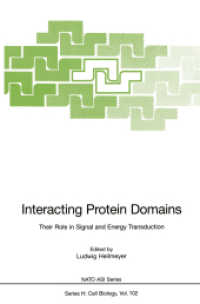- ホーム
- > 洋書
- > ドイツ書
- > Mathematics, Sciences & Technology
- > Earth Science
- > geography
Full Description
This book offers a comprehensive exploration of Multicriteria Decision Making (MCDM) models, presenting a novel approach to hazard monitoring that enhances decision-making. Using advanced GIS techniques and integrating both subjective and objective models, this volume addresses the complex interdependencies of various risk factors. The chapters here explore how MCDM methods can be effectively applied to assess and manage risks associated with natural disasters and other hazards. They highlight various MCDM methodologies such as the Analytic Hierarchy Process (AHP), Technique for Order of Preference by Similarity to Ideal Solution (TOPSIS), and Multi-Attribute Utility Theory (MAUT), each offering unique approaches to complex decision problems. The significance of these methods lies in their ability to accommodate diverse preferences and handle uncertainties that are inherent in the monitoring and management of hazards.
One of the central themes of the book is the holistic approach to hazard monitoring. This approach integrates various factors including hazard severity, the vulnerability of assets, and the likelihood of occurrence, economic implications, and societal impacts into a cohesive framework. This enables stakeholders to achieve a comprehensive understanding of hazards and their potential effects, facilitating more informed and robust decision-making. By showcasing applications across different domains such as disaster management, environmental risk assessment, urban planning, and infrastructure development, the book demonstrates the practical utility of MCDM in real-world settings. Each chapter provides detailed case studies and comparative analyses that illustrate how these methodologies can be applied to optimize hazard monitoring and risk assessment.
This book is useful to academic researchers and students in the fields of geography, environmental science, and disaster management, as well as professionals and policymakers involved in hazard assessment and mitigation. It serves as an essential resource for anyone looking to enhance their understanding of multicriteria decision-making processes and their application in the context of hazard monitoring and risk management.
Contents
Part 1: Observatory Persuasion.- Chapter 1: Introduction to Multicriteria Decision Making in Hazard Monitoring.- Chapter 2: Overview of The Holistic Approach and Book Structure.- Part 2: Multicriteria Decision Making Models.- Chapter 3: Multi-Criteria Decision-Making Framework For Identifying Multi-Hazard Risk Hotspots In Coastal Plains of South India.- Chapter 4: Flood Susceptibility Mapping In The Kaljani River Basin: Insights From AHP-PROMETHEE II and AHP Methods.- Chapter 5: Assessment of Landslide Susceptibility Along NH27 and NH627 In Assam, India Using GIS Based Multi Criteria Decision Making and Analytical Hierarchy Process.- Chapter 6: Assessment of Groundwater Potential Zone After Rohingya Rehabilitation Using GIS and Analytic Hierarchy Process (AHP) Techniques In Ukhia Sub-District, Cox's Bazar.- Chapter 7: GIS-Integrated Landslide Susceptibility Mapping In Teesta River Basin of Darjeeling-Sikkim Himalaya: A Comparative Analysis of Frequency Ratio, Logistic Regression Models, and Analytical Hierarchy Process.- Chapter 8: Spatial Assessment of Urban Resilience In The City District of Lahore Using GIS and Multicriteria Decision-Making Tools.- Chapter 9: Integrated Geomorphological and Hydrological Analysis for Flood Hazard Assessment in the Ngawun River Basin, Ayeyarwady Region, Myanmar.- Chapter 10: Flash Flood Susceptibility and Inundation Mapping Using Shannon's Entropy, Statistical Index, and HEC-RAS.- Part 3: Integrated Multicriteria Decision Making Models.- Chapter 11: An Application of MARCOS, CoCoSo, and GRA MCDM Models In A Hybrid Approach For Landslide Susceptibility Assessment In Wayanad District, Kerala (India).- Chapter 12: Utilizing Multicriteria Decision-Making Techniques For Computing Composite Vulnerability Over A Severely Flood-Prone Multi-Hazard Catchment.- Chapter 13: Flood Susceptibility Modelling of Tripura, India: An Application of Preference Selection Index (PSI) and Geospatial Technology.- Chapter 14: Socio-economic-cum-Physical Vulnerabilities To Riverine Floods Over Large Watersheds: A Comprehensive Framework By Leveraging Shannon Entropy and TOPSIS.- Chapter 15: Enhanced Landslide Susceptibility Assessment along Transport Infrastructures Through Hybrid Ensembled Learning Techniques.- Chapter 16: Advanced Optimization Techniques for Parameter Calibration In The DRASTIC Model: A Multi-Criteria Decision Analysis Approach To Groundwater Vulnerability Assessment.- Chapter 17: A Hybrid Novel Ensemble of Prediction Indices For GIS-Based Flood Susceptibility Zonation.- Chapter 18: GIS-Based Multi-Hazard Risk Analysis and Disaster Risk Reduction Planning Using Coupled Multi-Hazard Assessment Method.- Chapter 19: Hybrid Ensemble Approaches To Landslide Susceptibility Mapping: Fusing Advanced Multi-Criteria-Decision-Making With Machine Learning In Darjeeling Himalayas.- Part 4: Conclusion.- Chapter 20: Shifting Paradigms: The Rise of Multi-Criteria-Decision-Making Models Over Bivariate Statistical Approaches In Hazard Risk Assessment.- Chapter 21: Advancements In Multi-Criteria Decision-Making Models: A New Paradigm for Monitoring Flood Risks In Algeria.-Chapter 22: Usage and Future Path of MCDM For Hazard Monitoring and Risk Assessment.







